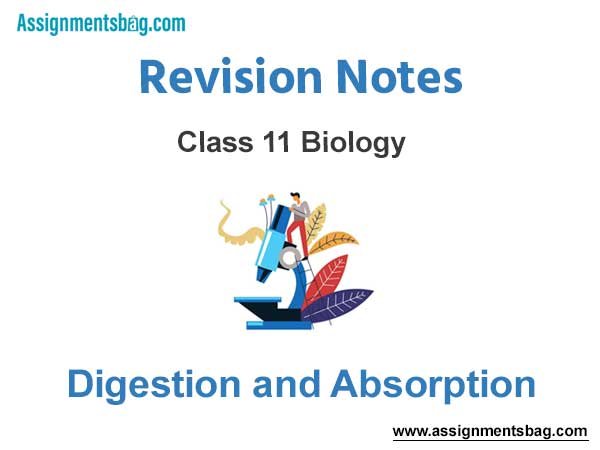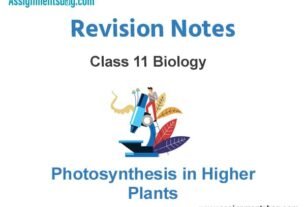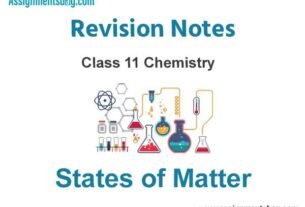Please see Digestion and Absorption Class 11 Biology Revision Notes provided below. These revision notes have been prepared as per the latest syllabus and books for Class 11 Biology issues by CBSE, NCERT, and KVS. Students should revise these notes for Chapter 16 Digestion and Absorption daily and also prior to examinations for understanding all topics and to get better marks in exams. We have provided Class 11 Biology Notes for all chapters on our website.
Chapter 16 Digestion and Absorption Class 11 Biology Revision Notes
♦ Nutrition is the getting and utilization of energy rich nutrients (food) by an organism.
♦ Food consists of carbohydrates, proteins, fats (lipids), vitamins, minerals and water.
♦ Food provides energy for life activities, materials for growth, maintains body temperature and repairs tissues.
♦ The water plays an important role in metabolic processes and prevents dehydration of the body.
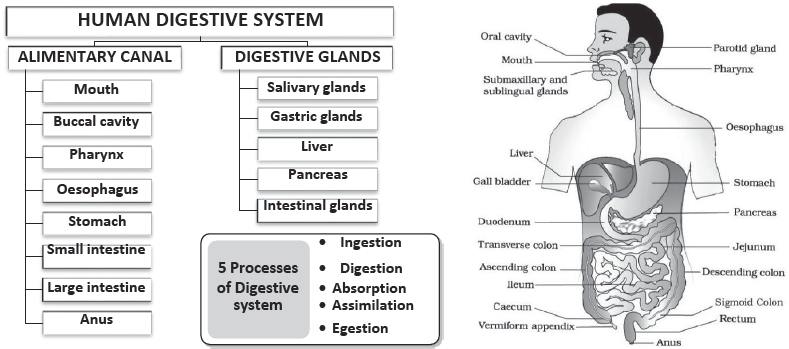
I. ALIMENTARY CANAL (GUT)
It includes the following parts:
1. Mouth: To receive the food (ingestion).
2. Buccal cavity (oral or mouth cavity):
♦ Consists of palate (roof), teeth & muscular tongue.
♦ Palate has anterior hard palate and posterior soft palate.
♦ Tongue is a muscular organ attached to the floor of oral cavity by the frenulum. Tongue has small projections called papillae. Some papillae bear taste buds.
♦ At the back, on either side of tongue tonsils present.
3. Pharynx:
♦ Common passage for digestive and respiratory systems.
♦ When food materials pass through the pharynx, the cartilaginous epiglottis closes the glottis (opening of larynx) and prevents the entry of food into trachea.
4. Oesophagus:
♦ Muscular tube (30 cm) that conducts food into stomach.
♦ Posterior part of the oesophagus has gastro-oesophageal sphincter (a circular muscle). It controls the opening of oesophagus into stomach.
5. Stomach:
♦ ‘J’ shaped structure for storage and digestion of food.
♦ 4 parts: a cardiac Body portion into which the oesophagus opens, a fundic region, body (main central region) and a pyloric portion (antrum).
♦ Pyloric stomach leads to small intestine by an opening called Pylorus, guarded by pyloric sphincter muscle.
♦ Inner wall of stomach bears rugae (longitudinal folds).
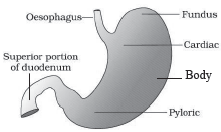
6. Small intestine:
♦ Longest part of gut (7 m long and 2.5 cm diameter).
♦ Consists 3 parts, namely duodenum (C shaped first part), Jejunum (middle part) and Ileum (terminal part).
♦ Finger-like villi are seen at the mucosa. Each villus has a brush-bordered columnar epithelial layer provided with microvilli. Villus consists of a capillary network and a small lymph vessel (lacteal).

7. Large intestine:
♦ 1.5 m long. Consists of caecum, colon and rectum.
♦ Caecum is well-developed in herbivores but very small in man. Arising from the caecum is a finger-like vestigial organ, the vermiform appendix.
♦ The colon consists of ascending colon, transverse colon, descending colon and Sigmoid colon.
♦ Pelvic colon leads to rectum that opens out by anus. Anus is guarded by anal sphincter (circular voluntary muscles).
♦ In some herbivores, the large intestine consists of several cellulose digesting bacteria.
TEETH
Nature & mode of arrangement of teeth is called dentition. Human dentition is Thecodont, Heterodont & Diphyodont.
Thecodont: It means teeth are placed in the jaw sockets.
Heterodont: It means different kinds of teeth are present. They are incisors (I) for cutting, canines (C) for tearing, premolars (PM) & molars (M) for mastication. Premolars & molars are collectively called as cheek teeth which have cusps.
Diphyodont: It means teeth appear twice in the lifetime. They are milk (deciduous) teeth and permanent teeth. Milk teeth (20 in number) are erupted at 6-7 months of birth. They are replaced by permanent teeth (32 in number) at the age of 6-7.

Last 4 molars (wisdom teeth) appear only at the age of 18.
The hard chewing surface of teeth is made up of enamel.
Dental formula: It explains the kinds and number of teeth.
Human dental formula (of permanent teeth):
I 2/2 C 1/1 PM 2/2 M 3/3 x 2 = 32 ( 2123 / 2123 )
Dental formula of milk dentition:
I 2/2 C 1/1 PM °/º M 2/2 x 2 = 20 ( 2102 / 2102 )
Histology of human gut (Transverse section)
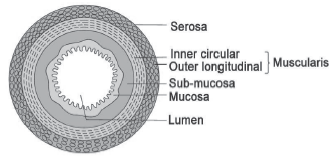
Human gut is formed of 4 layers:
1. Mucosa: Innermost, moist epithelial layer. Contains secretory and absorptive cells.
2. Submucosa: Soft connective tissue layer just outside the mucosa. Nerves and blood vessels are present.
3. Muscularis: Outer to submucosa. Smooth muscle layer (inner circular & outer longitudinal muscles).
4. Serosa: Outermost fibrous layer.
II. DIGESTIVE (ASSOCIATED) GLANDS
♦ They secrete digestive juices.
♦ They include salivary glands, gastric glands, intestinal glands, pancreas & liver.
a. Salivary glands
♦ 3 pairs. They are
Parotids (2): Largest salivary gland. Seen in cheeks.
Submaxillary/submandibular (2): Seen in lower jaw.
Sublingual (2): Below the tongue.
♦ Salivary glands secrete saliva. It contains 99.5% water, mucin (mucus), enzymes like salivary amylase (Ptyalin) and Lysozyme and electrolytes (Na+, K+, Cl–, HCO3– etc).
b. Gastric glands
Tubular glands found on the inner wall. They consist of
1. Mucus neck cells: Secrete mucus. Mucus and bicarbonates protect the stomach wall (mucosal epithelium) from HCl and prevents autodigestion.
2. Chief (zymogen or peptic) cells: Secrete proenzymes like pepsinogen & prorennin and some lipase.
3. Oxyntic (parietal) cells: Secrete HCl & Castle’s intrinsic factor (for absorption of vitamin B12).
Gastric glands secrete acidic (pH 1.8-2.0) gastric juice.
c. Liver
♦ Largest gland (1.2 – 1.5 kg). Reddish brown.
♦ Situated in abdominal cavity, just below the diaphragm.
♦ Bilobed (large right lobe & small left lobe). Each lobe is formed of hepatic lobules (structural & functional units).
♦ A lobule has many hepatic cells arranged as cords around a central vein. They secrete alkaline bile juice.
♦ Liver lobule is covered by Glisson’s capsule.
♦ Bile is transported from liver to duodenum as follows:
Bile → hepatic duct → gallbladder → cystic duct → common bile
duct → common hepato– pancreatic duct → duodenum
♦ Hepato-pancreatic duct is guarded by sphincter of Oddi.
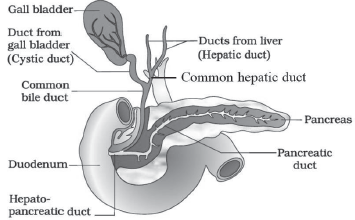
♦ Bile has no enzymes but contains bile pigments (bilirubin & biliverdin), bile salts, cholesterol and phospholipids.
d. Pancreas
♦ Second largest gland. Seen near duodenal loop.
♦ It is a cream-coloured heterocrine gland, i.e. it has both exocrine and endocrine parts.
♦ The exocrine part has a pancreatic duct that opens into duodenum along with bile duct (hepato-pancreatic duct).
♦ Exocrine part secretes alkaline pancreatic juice. It contains inactive protease enzymes (trypsinogen, hymotrypsinogen & procarboxypeptidases), amylases, lipases & nucleases.
e. Intestinal glands
♦ Simple tubular glands. 2 types:
1. Crypts of Lieberkuhn: Consists of mucus-secreting Goblet cells and enzyme-secreting Paneth cells.
2. Brunner (duodenal) glands: Confined to submucosa of duodenum. Secrete mucus only.
♦ Intestinal glands secrete alkaline intestinal juice (succus entericus). It contains enzymes (maltase, lactase, sucrase, dipeptidase, lipases, nucleotidases, nucleosidases etc).
♦ The bicarbonate and mucus provide alkaline medium and protect intestinal mucosa.
DIGESTION AND ABSORPTION OF FOOD
Digestion is the conversion of complex insoluble food materials into simple and absorbable form. It includes mechanical processes such as mastication (chewing), deglutition (swallowing) & peristalsis (wave-like movement of food bolus through the gut by muscular contraction).
♦ Digestion in buccal cavity: Only starch digestion. Ptyalin converts starch (polysaccharide) into disaccharides. About 30% of starch is digested by ptyalin.
Salivary amylase
Starch → Maltose + Isomaltose + limit dextrins
pH 6.8
♦ Digestion in stomach: Stomach stores food for 4-5 hrs. It is mixed with gastric juice by the churning movements and is converted into acidic pasty form (chyme).

The gastric lipase hydrolyses a small amount of lipids.
♦ Digestion in small intestine (in Duodenum): Chyme is mixed with succus entericus, pancreatic juice & bile juice.
(a) Action of bile: Bile helps in digestion by emulsification (conversion of fat into micelles or tiny droplets). It provides large surface area for the action of lipase on fat. Bile also activates lipase.
(b) Action of pancreatic juice: Amylopsin (Pancreatic amylase) hydrolyses remaining starch into disaccharides.
Amylopsin
Starch → Maltose + Isomaltose + limit dextrins
Enterokinase (Enterokinin) secreted by intestinal mucosa activates trypsinogen to active trypsin. Trypsin activates chymotrypsinogen & procarboxypeptidase.
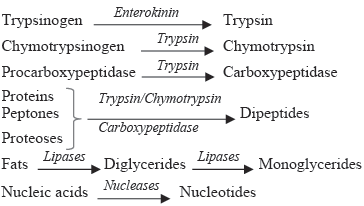
(c) Action of intestinal juice: At duodenum region, the intestinal enzymes act on the products of above reactions.


In large intestine, there is no significant digestive activity.
The functions of large intestine are:
a. Absorption of water, minerals and certain drugs.
b. Secretes mucus for adhering waste (undigested) particles together and lubricating it for an easy passage.
Fully digested semi fluid and alkaline food formed in small intestine is called chyle.
The digestive activities like gastric & intestinal secretions are controlled by neural and hormonal mechanisms. The sight, smell or presence of food in buccal cavity stimulate salivary secretions. Gastric & intestinal mucosa secretes digestive hormones. They control secretion of digestive juices.
ABSORPTION OF DIGESTED PRODUCTS
Absorption is the transfer of end products of digestion through the intestinal mucosa into blood & lymph. It is 2 types- passive and active.
(a) Passive absorption (Passive transport): Absorption of nutrients from higher concentrated region to lower concentrated region without the expenditure of energy. It includes osmosis (absorption of water) and diffusion (absorption of solute molecules).
Diffusion is 2 types:
1. Simple diffusion: In this, molecules alone can be diffused. E.g. Small amounts of monosaccharides like glucose, amino acids, vitamins, electrolytes like Cl- etc.
2. Facilitated diffusion: Diffusion with the help of carrier proteins. E.g. glucose, amino acids etc.
(b) Active absorption (Active transport): Absorption of nutrients from lower concentrated region to higher concentrated region (i.e. against concentration gradient). It needs energy. E.g. absorption of amino acids, monosaccharides like glucose, electrolytes like Na+ etc.
Absorption of lipids
♦ Monoglycerides, diglycerides and fatty acids cannot be absorbed directly as they are insoluble in water.
♦ Bile salts and phospholipids convert them into small spherical water-soluble droplets called micelles.
♦ They are reformed into small protein coated fat globules (chylomicrons). They are transported into lacteals in the villi. From the lymph, the chylomicrons enter the blood.
Absorption in different parts of alimentary canal
♦ Mouth: Certain drugs.
♦ Stomach: Water, simple sugars, some drugs & alcohol.
♦ Small intestine (mainly Jejunum & Ileum): All nutrients including minerals & vitamins.
It is the chief area of absorption due to the presence of villi, its great length and coiled nature.
♦ Large intestine: Water, some minerals & drugs.
The absorbed materials are incorporated into tissues for their activities. It is called assimilation.
The undigested substances like plant fibres, dead bacteria etc. form faeces. It enters caecum through the ileo-caecal valve, which prevents back flow of faeces.
Faeces are temporarily stored in rectum and are eliminated through anus. It is called egestion (defaecation).
CALORIFIC VALUE OF PROTEIN, CARBOHYDRATE & FAT (Not for evaluation)
♦ Heat is the ultimate source of all energies. So energy content of food is expressed as measure of heat energy.
♦ Its unit is calorie (cal) or joule (J).
♦ One calorie is the amount of heat energy required to raise the temperature of 1g of water by 1oC.
♦ This value is tiny amount of energy. So physiologists use kilocalorie (kcal or Cal) or kilo joule (kjl or Joule).
♦ One kilo calorie is the amount of energy required to raise the temperature of 1kg of water by 1oC.
♦ Amount of heat liberated from complete combustion of 1g food in a bomb calorimeter (a closed metal chamber filled with O2) is its gross calorific (gross energy) value.
♦ Actual amount of energy combustion of 1g of food is the physiologic value of food.

DISORDERS OF DIGESTIVE SYSTEM
1. Jaundice: Here, the skin and eye turns yellow due to the deposition of bile pigments. It indicates liver damage.
2. Vomiting: Ejection of stomach content through mouth. It is controlled by medulla oblongata.
3. Diarrhoea: Frequent elimination of watery faeces. It reduces the absorption of food.
4. Constipation: Infrequent elimination of dry stool. It is due to decreased peristalsis in colon.
5. Indigestion: Condition leading to feeling of fullness due to improper digestion. It is due to anxiety, inadequate enzyme secretion, food poisoning, spicy food etc.
6. Protein-Energy malnutrition (PEM): It is the dietary deficiencies of proteins & food calories.
PEM causes Marasmus & Kwashiorkor in children.
♦ Marasmus: It is due to deficiency of both proteins and calories. It is found in infants less than a year in age.
Reason: Replacement of mother’s milk by foods with poor proteins and caloric value. This often happens if mother has second pregnancy or child birth when the older infant is still too young.
Symptoms: Impaired growth and replacement of tissue proteins; extreme emaciation of the body, thin limbs, dry, thin and wrinkled skin, declined growth rate and body weight, impaired growth and development of brain and mental faculties.
♦ Kwashiorkor: It is due to protein deficiency only.
Reason: Replacement of mother’s milk by a high calorielow protein diet in a child more than one year in age.
Symptoms: Like marasmus, it shows wasting of muscles, thinning of limbs, failure of growth & brain development . Unlike marasmus, some fat is still under the skin; extensive oedema and swelling of body parts are seen.
